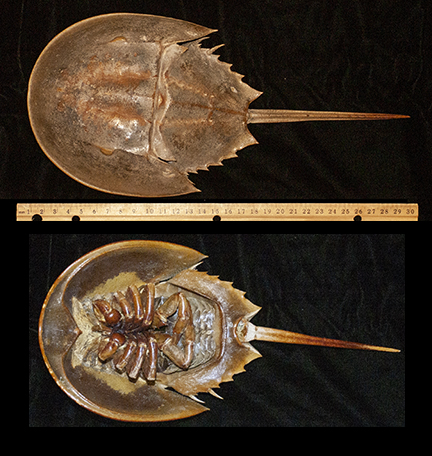| |
The sequence of amino acids in a protein directly reflects the DNA
that encodes the protein. The longer the time between the evolution
of two organisms, the more changes in the DNA sequence (mutations) encoding
the same protein in the two organisms. Thus, a comparison of amino acid
sequences from proteins of two difference organisms can help determine
the similarity in the DNA and therefore the evolutionary relatedness
of the species. The more similar the proteins, the more closely related
are the organisms. Amino acid sequencing is limited to use with groups
of organisms that share a common protein. Also, it cannot be assumed
that all organisms that share a protein are related.
This table shows the
amino acid sequences for a fragment of a protein (cytochrome c)
in different organisms. The next 11 amino acids in the sequence
(not shown) are identical for all the organisms. Three-letter
abbreviations indicate the amino acids. The similarity among the
species is striking |
| Man |
Asp |
Thr |
Leu |
Met |
Glu |
Tyr |
Leu |
Glu |
| Chimpanzee |
Asp |
Thr |
Leu |
Met |
Glu |
Tyr |
Leu |
Glu |
| Calif. gray whale |
Glu |
Thr |
Leu |
Met |
Glu |
Tyr |
Leu |
Glu |
| Baker’s yeast |
Asn |
Asn |
Met |
Ser |
Glu |
Tyr |
Leu |
Thr |
| Tobacco hornworm |
Asp |
Thr |
Leu |
Phe |
Glu |
Tyr |
Leu |
Glu |
| Cauliflower |
Lys |
Thr |
Leu |
Tyr |
Asp |
Tyr |
Leu |
Glu |
| Wheat germ |
Asn |
Thr |
Leu |
Tyr |
Asp |
Tyr |
Leu |
Leu |
Immunodiffusion test. Antibodies are in the center well and serum from 6 different animals in in wells A through F. Which two animals are most clsely relaated? |
 |
| |
|
Electrophoresis of proteins. Protein profiles
of the proteins in a cell are made because a cell's proteins are
products of its genes, each species is expected to produce a unique
set of proteins.We assume that identical organisms have identical
protein profiles, that the proilfes of closely related organisms
show only minor differences, and that the profiles of distantly
related organisms show major differences. In the gel shown to the right,
which organisms are most closely related? Which two are related,
but not closely? |
 |
| |
|
| Limulus (Horseshoe crab) |
 |
|

